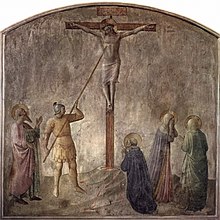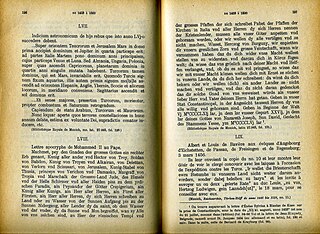
Apocrypha are biblical or related writings not forming part of the accepted canon of Scripture. While some might be of doubtful authorship or authenticity, in Christianity, the word apocryphal (ἀπόκρυφος) was first applied to writings which were to be read privately rather than in the public context of church services. Apocrypha were edifying Christian works that were not considered canonical scripture. It was not until well after the Protestant Reformation that the word apocrypha was used by some ecclesiastics to mean "false," "spurious," "bad," or "heretical."
The deuterocanonical books are books and passages considered by the Catholic Church, the Eastern Orthodox Church, the Oriental Orthodox Churches or the Assyrian Church of the East to be canonical books of the Old Testament, but which modern Jews and Protestants regard as apocrypha.
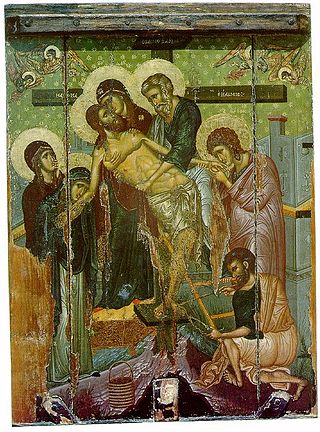
Joseph of Arimathea was, according to all four canonical gospels, a Pharisee who assumed responsibility for the burial of Jesus after his crucifixion. The historical location of Arimathea is uncertain, although it has been identified with several towns. A number of stories that developed during the Middle Ages.
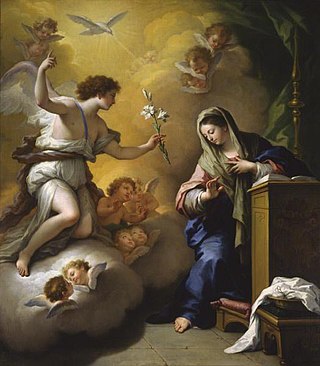
Archangels are the second-lowest rank of angel in the Christian hierarchy of angels, put forward by Pseudo-Dionysius the Areopagite in the 5th or 6th century in his book De Coelesti Hierarchia. The word "archangel" itself is usually associated with the Abrahamic religions, but beings that are very similar to archangels are found in a number of other religious traditions.
Many Wikipedia articles on religious topics are not yet listed on this page. If you cannot find the topic you are interested in on this page, it still may already exist; you can try to find it using the "Search" box. If you find that it exists, you can edit this page to add a link to it.

In Jewish and Christian traditions, Jannes and Jambres are the names given to magicians mentioned in the Book of Exodus. This naming tradition is well-attested in ancient and medieval literature. In Latin manuscripts of the New Testament, and in Latin writing traditions, their names are known as Jamnes and Mambres.

Nicodemus is a New Testament figure venerated as a saint in a number of Christian traditions. He is depicted as a Pharisee and a member of the Sanhedrin who is drawn to hear Jesus's teachings. As is the case with Lazarus, Nicodemus is not mentioned in the synoptic Gospels, and is mentioned only by John, who devotes more than half of Chapter 3 of his gospel and a few verses of Chapter 7 to Nicodemus, and lastly mentions him in Chapter 19.

The Gospel of Nicodemus, also known as the Acts of Pilate, is an apocryphal gospel claimed to have been derived from an original Hebrew work written by Nicodemus, who appears in the Gospel of John as an associate of Jesus. The title "Gospel of Nicodemus" is medieval in origin. The dates of its accreted sections are uncertain, but the work in its existing form is thought to date to around the 4th or 5th century AD.

Uriel, Auriel or Oriel is the name of one of the archangels who is mentioned in the post-exilic rabbinic tradition and in certain Christian traditions. He is well known in the Russian Orthodox tradition and in folk Catholicism and recognised in the Anglican Church as the fourth archangel. He is also well known in European esoteric medieval literature. Uriel is also known as a master of knowledge and archangel of wisdom.

In the New Testament, Salome was a follower of Jesus who appears briefly in the canonical gospels and in apocryphal writings. She is named by Mark as present at the crucifixion and as one of the Myrrhbearers, the women who found Jesus's empty tomb. Interpretation has further identified her with other women who are mentioned but not named in the canonical gospels. In particular, she is often identified as the wife of Zebedee, the mother of James and John, two of the Twelve apostles. In medieval tradition Salome was counted as one of the Three Marys who were daughters of Saint Anne, so making her the sister or half-sister of Mary, mother of Jesus.

The New Testament apocrypha are a number of writings by early Christians that give accounts of Jesus and his teachings, the nature of God, or the teachings of his apostles and of their lives. Some of these writings were cited as scripture by early Christians, but since the fifth century a widespread consensus has emerged limiting the New Testament to the 27 books of the modern canon. Roman Catholic, Eastern Orthodox, and Protestant churches generally do not view the New Testament apocrypha as part of the Bible.
The unnamed wife of Pontius Pilate appears only once in the Gospel of Matthew (27:19), where she intercedes with Pilate on Jesus' behalf. It is uncertain whether Pilate was actually married, although it is likely. In later tradition, she becomes known as Procula or Procla and plays a role in various New Testament Apocrypha. At a later date, she acquires the name Claudia Procula in Western tradition, as well as other names and variants of these names. She is venerated as a saint by the Eastern Orthodox Church, the Eastern Catholic Church, the Coptic Church, and the Ethiopian Church. She has also frequently been featured in literature and film.

The seventy disciples, known in the Eastern Christian traditions as the seventy apostles, were early emissaries of Jesus mentioned in the Gospel of Luke.
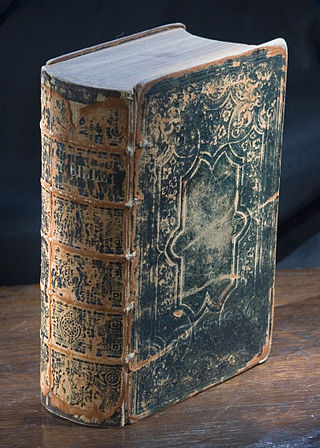
Disputes regarding the internal consistency and textual integrity of the Bible have a long history.

The concept of Seven Archangels is found in some works of early Jewish literature and in Christianity. In those texts, they are referenced as the angels who serve God directly.

In Eastern Orthodox Christian tradition the Myrrhbearers are the individuals mentioned in the New Testament who were directly involved in the burial or who discovered the empty tomb following the resurrection of Jesus. The term traditionally refers to the women who came with myrrh to the tomb of Christ early in the morning to find it empty. Also included are Joseph of Arimathea and Nicodemus, who took the body of Jesus down from the cross, anointed it with myrrh and aloes, wrapped it in clean linen, and placed it in a new tomb. In Western Christianity, the women at the tomb, the Three Marys or other variants are the terms normally used.
The Old Testament is the first section of the two-part Christian biblical canon; the second section is the New Testament. The Old Testament includes the books of the Hebrew Bible (Tanakh) or protocanon, and in various Christian denominations also includes deuterocanonical books. Orthodox Christians, Catholics and Protestants use different canons, which differ with respect to the texts that are included in the Old Testament.
A biblical canon is a set of texts which a particular Jewish or Christian religious community regards as part of the Bible.

For the majority of Christian denominations, the Holy Spirit, or Holy Ghost, is believed to be the third person of the Trinity, a triune God manifested as God the Father, God the Son, and God the Holy Spirit, each being God. Nontrinitarian Christians, who reject the doctrine of the Trinity, differ significantly from mainstream Christianity in their beliefs about the Holy Spirit. In Christian theology, pneumatology is the study of the Holy Spirit. Due to Christianity's historical relationship with Judaism, theologians often identify the Holy Spirit with the concept of the Ruach Hakodesh in Jewish scripture, on the theory that Jesus was expanding upon these Jewish concepts. Similar names, and ideas, include the Ruach Elohim, Ruach YHWH, and the Ruach Hakodesh. In the New Testament it is identified with the Spirit of Christ, the Spirit of Truth, the Paraclete and the Holy Spirit.








